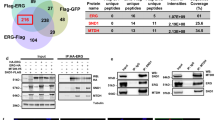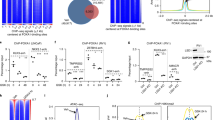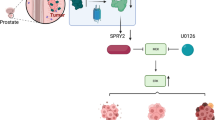Abstract
In this project, we studied the gene regulation of 15-lipoxygenase 2 (15-LOX2), the most abundant arachidonate-metabolizing LOX in adult human prostate and a negative cell-cycle regulator in normal human prostate (NHP) epithelial cells. Through detailed in silico promoter examination and promoter deletion and activity analysis, we found that several Sp1 sites (i.e., three GC boxes and one CACCC box) in the proximal promoter region play a critical role in regulating 15-LOX2 expression in NHP cells. Several pieces of evidence further suggest that the Sp1 and Sp3 proteins play a physiologically important role in positively and negatively regulating the 15-LOX2 gene expression, respectively. First, mutations in the GC boxes affected the 15-LOX2 promoter activity. Second, both Sp1 and Sp3 proteins were detected in the protein complexes that bound the GC boxes revealed by electrophoretic mobility shift assay. Third, importantly, inhibition of Sp1 activity or overexpression of Sp3 both inhibited the endogenous 15-LOX2 mRNA expression. Since 15-LOX2 is normally expressed in the prostate luminal epithelial cells, we subsequently explored whether androgen/androgen receptor may directly regulate its gene expression. The results indicate that androgen does not directly regulate 15-LOX2 gene expression. Together, these observations provide insight on how 15-LOX2 gene expression may be regulated in NHP cells.
This is a preview of subscription content, access via your institution
Access options
Subscribe to this journal
Receive 50 print issues and online access
$259.00 per year
only $5.18 per issue
Buy this article
- Purchase on Springer Link
- Instant access to full article PDF
Prices may be subject to local taxes which are calculated during checkout








Similar content being viewed by others
Abbreviations
- AA:
-
arachidonic acid
- AR:
-
androgen receptor
- DN:
-
dominant negative
- EMSA:
-
electrophoretic mobility shift assay
- LOX:
-
lipoxygenase
- 15-LOX2:
-
15-lipoxygenase 2
- 15-LOX2sv-a/b/c:
-
15-LOX2 splice variant a, b or c
- MMA:
-
mithramycin A
- NE:
-
nuclear extract
- NHP:
-
normal human prostate epithelial cells
- PCa:
-
prostate cancer
- RLU:
-
relative luciferase unit
- TSS:
-
transcription start site
References
Bhatia B, Maldonado CJ, Tang S, Chandra D, Klein RD, Chopra D, Shappell SB, Yang P, Newman RA and Tang DG . (2003). J. Biol. Chem., 278, 25091–25100.
Black AR, Black JD and Azizkhan-Clifford J . (2001). J. Cell. Physiol., 188, 143–160.
Blais A, Monte D, Pouiot F and Labrie C . (2002). J. Biol. Chem., 277, 31679–31693.
Brash AR, Boeglin WE and Chang MS . (1997). Proc. Natl. Acad. Sci. USA, 94, 6148–6152.
Chen BK and Chang WC . (2000). Proc. Natl. Acad. USA, 97, 10406–10411.
Chopra DP, Grignon DJ, Joiakim A, Mathieu PA, Mohamed A, Sakr WA, Powell IJ and Sarkar FH . (1996). J. Cell. Physiol., 169, 269–280.
Frith MC, Hansen U and Weng Z . (2001). Bioinformatics, 17, 878–889.
Garcia-Ruiz I, de la Torre P, Diaz T, Esteban E, Fernandez I, Munoz-Yague T and Solis-Herruzo JA . (2002). J. Biol. Chem., 277, 30551–30558.
Grinstein E, Jundt F, Weinert I, Wernet P and Yoyer H-D . (2002). Oncogene, 21, 1485–1492.
Hagen G, Muller S, Beato M and Suske G . (1994). EMBO J., 13, 3843–3851.
Heinemeyer T, Wingender E, Reuter I, Hermjakob H, Kel A, Kel O, Ignatieva E, Ananko E, Podkolodnaya O, Kolpakov F, Podkolodny N and Kolchanov N . (1998). Nucleic Acid Res., 26, 364–370.
Hong C, Kim H-A, Firestone GL and Bjeldanes LF . (2002). Carcinogenesis, 23, 1297–1305.
Huang L, Sowa Y, Sakai T and Pardee AB . (2000). Oncogene, 19, 5712–5719.
Jackson SP, MacDonald JJ, Lees-Miller S and Tijan R . (1990). Cell, 63, 155–165.
Kaluz S, Kaluzova M and Stanbridge EJ . (2003). Cancer Res., 63, 917–922.
Kelavkar U, Wang S, Montero A, Murtagh J, Shah K and Badr K . (1998). Mol. Biol. Reports, 25, 173–182.
Kilty I, Alison L and Vickers PJ . (1999). Eur. J. Biochem., 266, 83–93.
Kingsley C and Winoto A . (1992). Mol. Cell. Biol., 12, 4251–4261.
Kritzik MR, Ziober AF, Dicharry S, Conrad DJ and Sigal E . (1997). Biochim. Biophys. Acta, 1352, 267–281.
Kumar AP and Butler AP . (1997). Nucleic Acid Res., 25, 2012–2019.
Levine M and Tijan R . (2003). Nature, 424, 147–151.
Liang F, Schaufele F and Gardner DG . (2001). J. Biol. Chem., 276, 1516–1522.
Locker J . (1993). Gene Transcription: A Practical Approach Hames BD and Higgins SJ (eds). Oxford University Press: Oxford, UK, pp. 321–345.
Matys V, Fricke E, Gefferes R, Goβling E, Haubrock M, Hehl R, Hornischer K, Karas D, Kel AE, Kel-Margoulis OV, Kloos D-U, Land S, Lewicki-Potapov B, Michael H, Munch R, Reuter I, Rotert S, Saxel H, Scheer M, Thiele S and Wingender E . (2000). Nucleic Acid Res., 28, 316–319.
Ptersohn D and Thiel G . (1996). Eur. J. Biochem., 239, 827–834.
Sambrook J and Russell DW . (2001). Molecular Cloning: A Laboratory Manual 3rd edn., Vol. 1. CSHL Press, Cold Spring Harbor Laboratory: New York, pp. 7.75–7.81.
Schafer G, Cramer T, Suske G, Kemner W, Wiedenmann B and Hocker M . (2003). J. Biol. Chem., 278, 8190–8198.
Shappell SB, Boeglin WE, Olson SJ, Kasper S and Brash AR . (1999). Am. J. Pathol., 155, 235–245.
Strachan T and Read AP . (2000). Human Molecular Genetics 2nd edn. Wiley-Liss: New York, pp. 169–208.
Tang DG, Li L, Chopra D and Porter AT . (1998). Cancer Res., 58, 3466–3479.
Tang S, Bhatia B, Maldonado C, Yang P, Newman RA, Liu J, Chandra D, Traag J, Klein RD, Fischer SM, Chopra D, Shen J, Zhau H, Chung LWK and Tang DG . (2002). J. Biol. Chem., 277, 16189–16201.
Won J, Yim J and Kim TK . (2002). J. Biol. Chem., 277, 38230–38238.
Yamada K, Tanaka T, Miyamoto K and Noguchi T . (2000). J. Biol. Chem., 275, 18129–18137.
Zhang J, Thomas TZ, Kasper S and Matusik RJ . (2000). Endocrinology, 141, 4698–4710.
Acknowledgements
We thank D Chopra for NHP2 cells, G Thiel for DN-Sp1, L W-K Chung for AR, R Matusik for the ARR2PB promoter, J-J Shen and Molecular Biology Core for assistance in sequencing, and members of the Tang lab for helpful discussions. This work is supported, in part, by R01 CA90297, ACS Grant RSG-03-163-01-MGO, DOD grant DAMD17-03-1-0137, and NIEHS Center Grant ES07784. SL Friedman is supported by R01 DK 37340. CJ Maldonado is supported by NIH post-doctoral training grant T32 CA09480-16. D Chandra is supported by DOD Postdoctoral Traineeship Award DAMD17-02-1-0083. B Bhatia is a graduate student in GSBS program.
Author information
Authors and Affiliations
Corresponding author
Rights and permissions
About this article
Cite this article
Tang, S., Bhatia, B., Zhou, J. et al. Evidence that Sp1 positively and Sp3 negatively regulate and androgen does not directly regulate functional tumor suppressor 15-lipoxygenase 2 (15-LOX2) gene expression in normal human prostate epithelial cells. Oncogene 23, 6942–6953 (2004). https://doi.org/10.1038/sj.onc.1207913
Received:
Revised:
Accepted:
Published:
Issue Date:
DOI: https://doi.org/10.1038/sj.onc.1207913
Keywords
This article is cited by
-
Involvement of GATA1 and Sp3 in the activation of the murine STING gene promoter in NIH3T3 cells
Scientific Reports (2017)
-
Identification of genes and candidate agents associated with pancreatic cancer
Tumor Biology (2014)
-
Inhibition of cystathionine β-synthase is associated with glucocorticoids over-secretion in psychological stress-induced hyperhomocystinemia rat liver
Cell Stress and Chaperones (2013)
-
Involvement of a specificity proteins-binding element in regulation of basal and estrogen-induced transcription activity of the BRCA1gene
Breast Cancer Research (2008)
-
15-Lipoxygenase-2 gene regulation by its product 15-(S)-hydroxyeicosatetraenoic acid through a negative feedback mechanism that involves peroxisome proliferator-activated receptor γ
Oncogene (2006)



